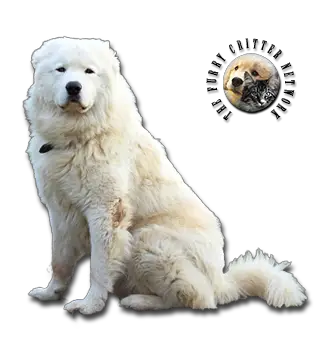Breed Standard
Head: Large, flat, wedge-shaped; similar to that of the polar bear. Stop not pronounced.
Ears: Set on high. Relatively small, drop, triangular (v-shaped). Cropped ears acceptable for working dogs.
Eyes: Almond-shaped, relatively small in relation to the rest of the body. Ocher or dark brown color.
Body: Length greater than height. Large, strong neck. Deep chest is well open. Well-sprung ribs. Rectangular back. Powerful, muscular, slightly sloped croup.
Tail: Covered with thick hair. Set on low. Carried down when relaxed; when alert, carried at the level of the back with the tip curved up.
Hair: Thick, long (8 cm on the body, 2.5 in), harsh to the touch. Short on the head. Collarette and fringes on the back of the legs. Heavy undercoat in winter.
Coat: Solid white. Ivory, pale orange, or lemon nuances are permitted.
Size: Dog: 65 to 73 cm. (25.6-28.7 in).Bitch: 60 to 68 cm. (23.6-26.8 in).
Weight: Dog: 35 to 45 kg. (77-99 lb).Bitch: 30 to 40 kg. (66-88 lb).
History
It is believed that the Maremma Sheepdog is an ancient breed. The Roman agronomist Varro mentions a breed of white dogs in his writings as early as 100 BC. Like most European Molossian types, this breed's roots can be traced to the shepherd dogs of central Asia that arrived in Western Europe with the Mongols. Until 1950/1960, the Maremma Sheepdog (short-haired) was distinguished from the longer-haired Abruzzes Sheepdog. It was determined that this distinction had been made only because of the fact that this dog worked from June to October in the Abruzzes and from October to June in the region of Maremma. Approximately twenty-five years ago, Prof. G. Solaro wrote one standard for the breed and the names were joined.
Behavior
Calm, reflective, but proud and not likely to be submissive, this dog needs firm training. He is devoted to his owner, is good with children, and makes a good companion. Very distrustful of strangers, he is a reliable, dedicated guardian. This breed is not suited for apartment living. He needs space and a lot of exercise. This robust dog does not stand heat well. Regular brushing is required.
Function
The traditional use of the Maremmano is as a guardian for the protection of sheep flocks against wolves. Columella, writing in the first century AD, recommends white dogs for this purpose, as the shepherd can easily distinguish them from the wolf, while Varro suggests that white dogs have a "lion-like aspect" in the dark. The dogs work in groups; three or four dogs are an adequate defense against wolves and stray dogs. Their function is mostly one of dissuasion, actual physical combat with the predator being relatively rare. Nevertheless, working dogs may be fitted with a roccale (or vreccale), a spiked iron collar which protects the neck in combat. The ears of working dogs are normally cropped.
Dogs used for flock protection are placed among the sheep as young puppies – no more than 40 days old – so that they bond with them; human contact is kept to the indispensable minimum. If there are already guardian dogs in the flock, the puppy imitates and learns from their behaviour. The traditional use of the Maremmano is with sheep, but the dogs can form a similar bond with cattle and have been used to protect them. A small number have been used since 2006 on Middle Island, off Warrnambool, in Victoria, Australia, to protect a small population of the little penguin (Eudyptula minor) against foxes. In Patagonia they have been used to protect sheep from pumas.
Health
Very healthy, although Maremmas may suffer from hip dysplasia, elbow dysplasia, and eye disease.






